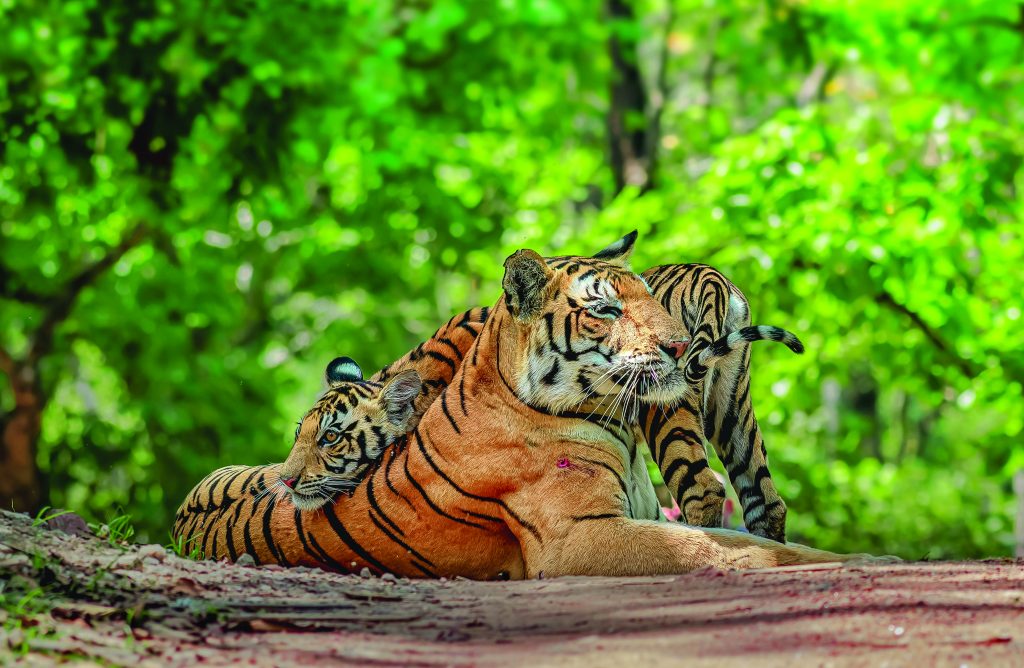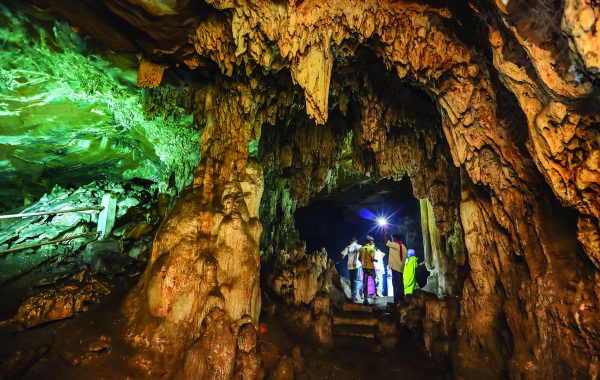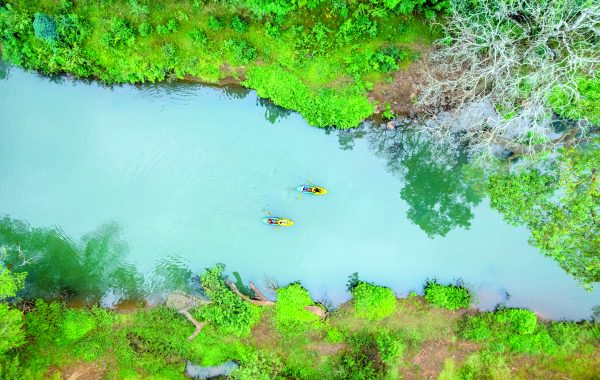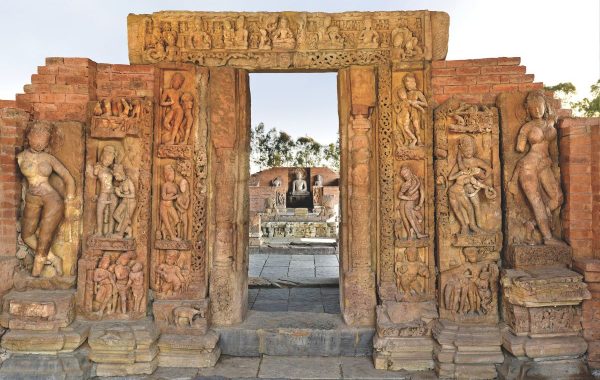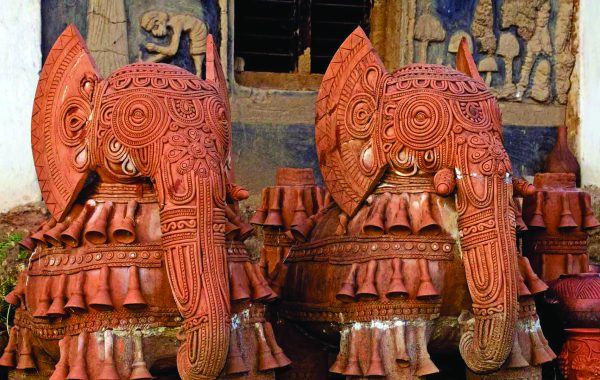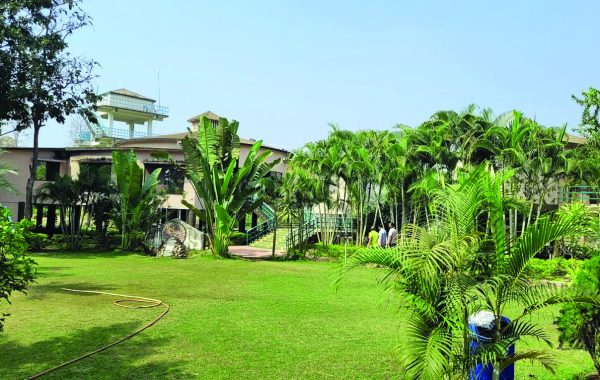Explore the untamed beauty of Chhattisgarh – your ultimate guide to national parks, tiger reserves, and unique wildlife experiences.
Chhattisgarh is a treasure trove of wildlife, offering a diverse ecosystem of lush forests, rolling hills, and serene grasslands that serve as a sanctuary for a wide variety of flora and fauna. The state is home to several tiger reserves and its wildlife sanctuaries are teeming with biodiversity, providing refuge for species such as leopards, sloth bears, wild boars, and a plethora of birdlife. These protected areas are vital not only for preserving endangered species but also for maintaining ecological balance. Visitors can experience the thrill of spotting wildlife while exploring the dense jungles, making Chhattisgarh a captivating destination for nature enthusiasts and wildlife photographers.
TIGER RESERVES
INDRAVATI TIGER RESERVE
Indravati Tiger Reserve, located in Chhattisgarh’s Bijapur district, is named after the Indravati River, which flows along its northern boundary. Established as a national park in 1981 and designated a tiger reserve in 1983 under India’s Project Tiger, it spans approximately 2,799 square km.
The reserve is renowned for its diverse flora and fauna. It harbours one of the last populations of the endangered wild Asian buffalos, alongside other species such as tigers, Gaurs (Indian bison), leopards, bears, nilgai, wild deer, sambar and cheetal.
The park’s landscape features tropical moist and dry deciduous forests, interspersed with grasslands and bamboo groves, offering rich biodiversity for nature enthusiasts.
How to Reach:
By Air: Swami Vivekananda International Airport in Raipur (480 km), Maa Danteshwari Airport Jagdalpur (107km)
By Train: Nearest railway station Jagdalpur (approximately 96 km)
By Road: Raipur (approximately 480 km), Jagdalpur (105km)
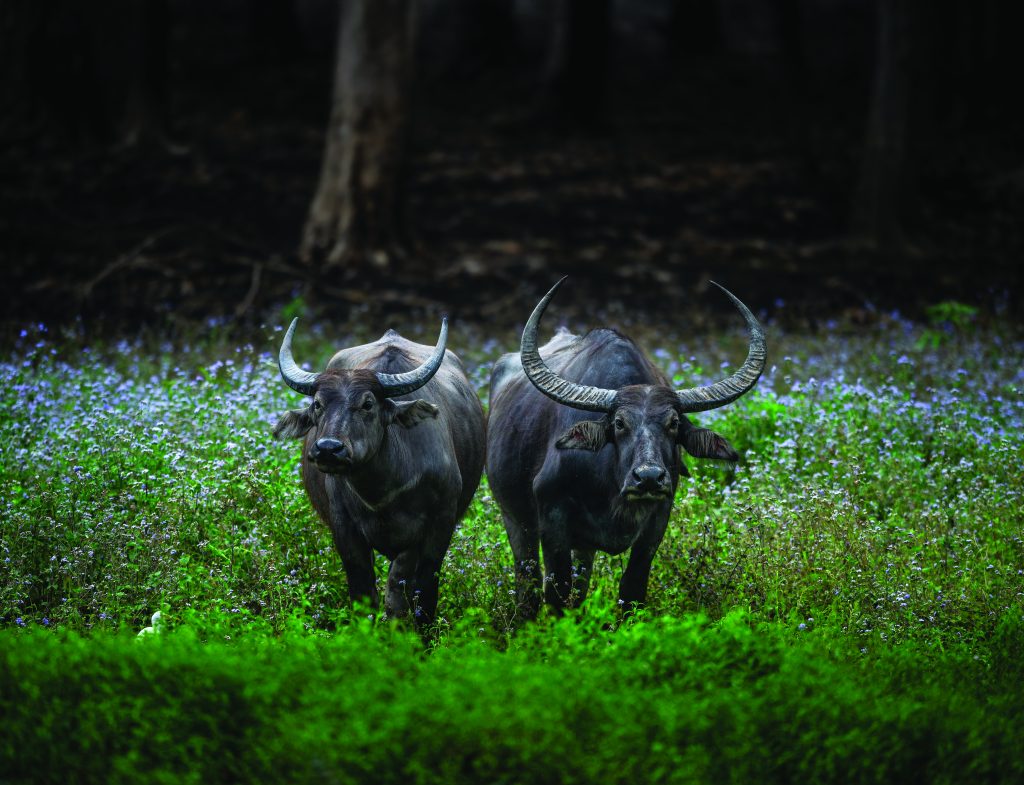
ACHANAKMAR TIGER RESERVE
Located in the heart of Chhattisgarh, Achanakmar Tiger Reserve spans over 914 square km and forms part of the Achanakmar-Amarkantak Biosphere Reserve. This vast expanse of dense sal, bamboo, and teak forests is a sanctuary for an array of wildlife, including tigers, leopards, bison, chital, sambhar, and a variety of bird species. Nature lovers will find themselves enchanted by the reserve’s serene landscapes, filled with biodiversity and offering excellent opportunities for wildlife sightings.
What to See:
Visitors can embark on safaris to explore the rich flora and fauna of the reserve. The sight of majestic tigers, coupled with the beauty of the lush greenery and the calls of exotic birds, creates an unforgettable experience. The area’s rivers, streams, and hilly terrain add to the reserve’s scenic charm, making it ideal for photographers and nature enthusiasts.
How to Reach:
By Air: Swami Vivekananda Airport in Raipur (205 km), Bilasa Devi Kevat Airport in Bilaspur (88.6km)
By Train:, The closest railway station is Bilaspur Junction (82 km).
By Road: Raipur (175km); Bilaspur (78km)
UDANTI-SITANADI TIGER RESERVE
The Udanti-Sitanadi Tiger Reserve in Chhattisgarh is a vital wildlife conservation area, spanning around 1,842 sq km. Established as a tiger reserve in 2009, it combines two historically significant sanctuaries. The Sitanadi Wildlife Sanctuary, created in 1974, named after the Sitanadi River, which originates within its boundaries and joins the Mahanadi River near Deokhut. It is well-known for its lush greenery and diverse fauna. The Udanti Wildlife Sanctuary, established in 1983 and named after the Udanti River flowing west to east, is particularly recognised for its population of endangered wild buffaloes.
What To See:
The reserve is a must-visit for wildlife enthusiasts. The dense forests and open grasslands provide excellent opportunities for nature walks and wildlife photography. The core areas of the Udanti-Sitanadi Tiger Reserve host a diverse range of Central India’s representative wildlife. The critically endangered Asiatic Wild Buffalo is the reserve’s flagship species. In addition to tigers, other rare and endangered animals include the Indian wolf, leopard, sloth bear, and mouse deer.
How to Reach
By Air: Swami Vivekananda Airport in Raipur (162 km).
By Train: The closest railway station is in Raipur (approximately 173 km)
By Road: Raipur (approximately 170 km).
GURU GHASIDAS-TAMOR PINGLA TIGER RESERVE
In 2024, the Guru Ghasidas-Tamor Pingla Tiger Reserve was officially declared a tiger reserve, becoming the fourth in the state. Spanning a total area of 2,829.38 sq km, the reserve includes a core zone of 2,049.2 sq km that encompasses both the Guru Ghasidas National Park and the Tamor Pingla Wildlife Sanctuary. Additionally, a buffer zone of 780.15 sq km has been designated for the reserve. This makes it the third-largest tiger reserve in India. Spread across Manendragarh-Chirmiri-Bharatpur, Koriya, Surajpur, and Balrampur districts, the Guru Ghasidas-Tamor Pingla Tiger Reserve adopts a landscape-based conservation model under India’s National Wildlife Plan. It forms a 4,500 sq km corridor with Sanjay Dubri Tiger Reserve and connects ecologically with Bandhavgarh to the west and Palamau to the east.
What to See:
Spot majestic tigers and observe a variety of mammals, reptiles, and amphibians in their natural habitat. The reserve comprises a wide range of wildlife species (apart from tigers) such as elephants, sloth bears, vultures, peacocks, wolves, leopards, otters, chitals, jackals, nilgai, bison, hyenas, langurs, cobras etc. Famous for its scenic beauty and peaceful surroundings, this sanctuary offers excellent opportunities for birdwatching and photography.
How to Reach
By Air: Swami Vivekananda Airport in Raipur (326 km), Bilasa Devi Kevat Airport in Bilaspur (197km)
By Train: The closest railway stations are – Surajpur (40 km) and Ambikapur (68 km).
By Road: Raipur (approximately 310 km), Ambikapur (72 km), Bilaspur (193 km)
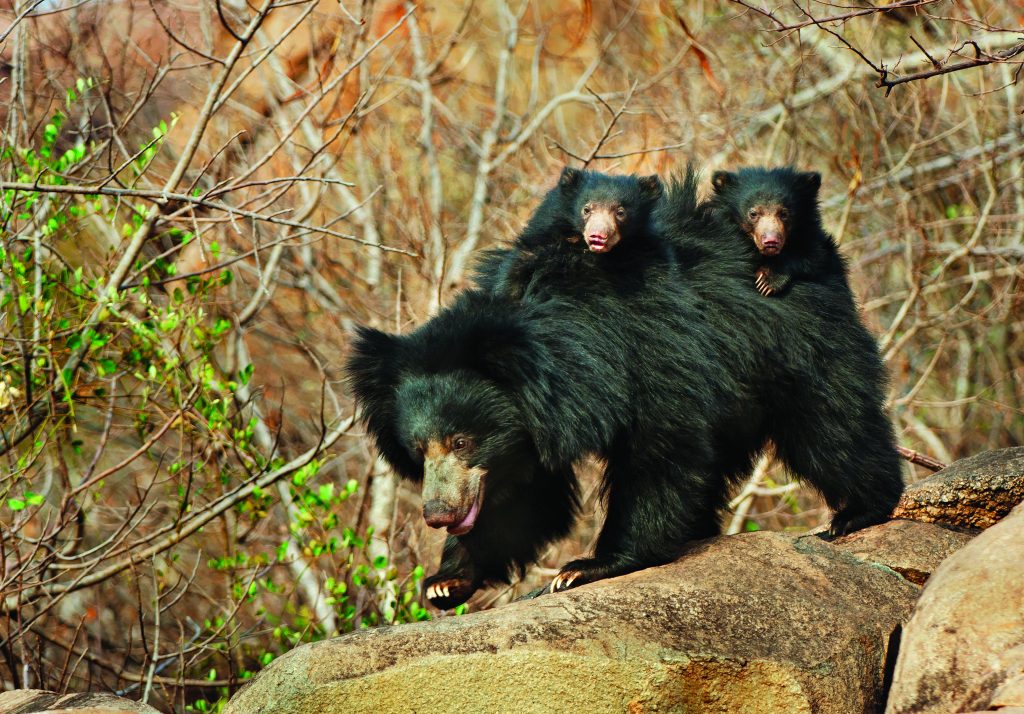
KANGER VALLEY NATIONAL PARK
Located in the scenic Bastar region of Chhattisgarh, Kanger Valley National Park is a hidden gem for nature enthusiasts and wildlife lovers. Spanning approximately 200 square km, this biodiverse sanctuary is renowned for its lush forests, stunning waterfalls, and fascinating geological formations. Recognised as a biodiversity hotspot, the park is home to several endangered species.
What To See
Kanger Valley National Park is bustling with diverse flora and fauna, making it a paradise for wildlife enthusiasts. The park is home to a variety of mammals, including leopards, tigers, sloth bears, and wild boars. Birdwatchers will delight in spotting over 150 species of birds, including the rare hill myna and the colourful Indian pitta. Visitors can also explore the 200-meter-long Kotumsar Cave, featuring stalactites and stalagmites, or marvel at the 300-foot Tirathgarh Waterfalls, set in a picturesque valley. Guided tours and nature trails offer a chance to discover the park’s rich biodiversity and cultural significance, with informative interpretation centers enhancing the experience.
How to Reach
By Air: Swami Vivekananda Airport in Raipur (310 km), Maa Danteshwari Airport Jagdalpur (50km)
By Train: The closest railway stations are – Jagdalpur (22 km) and Raipur (320 km).
By Road: Raipur (320 km), Jagdalpur (22 km).
PAMED WILDLIFE SANCTUARY
Pamed Wildlife Sanctuary, located in the Dantewada district of southern Chhattisgarh, spans 262 sq km and is a vital wildlife reserve near the Andhra Pradesh border. Known for its rich biodiversity, the sanctuary is home to dense mixed forests of sal and teak, creating a calm and enchanting atmosphere.
Things to See
The sanctuary is a perfect place for deer enthusiasts, offering sightings of species like the chital (spotted deer), Indian gazelle, and chinkara. Visitors can marvel at the sight of these graceful creatures roaming freely in their natural habitat. The dense forests and lush greenery provide a tranquil environment for nature lovers, making it an ideal spot for them to capture the beauty of untamed wilderness.
How to Reach
By Air: Swami Vivekananda Airport in Raipur (approximately 400 km), Maa Danteshwari Airport Jagdalpur (254km)
By Train: The closest railway stations are – Kirandul (127 km) and Raipur (400 km).
By Road: Raipur (approximately 400 km), Kirandul (129 km).
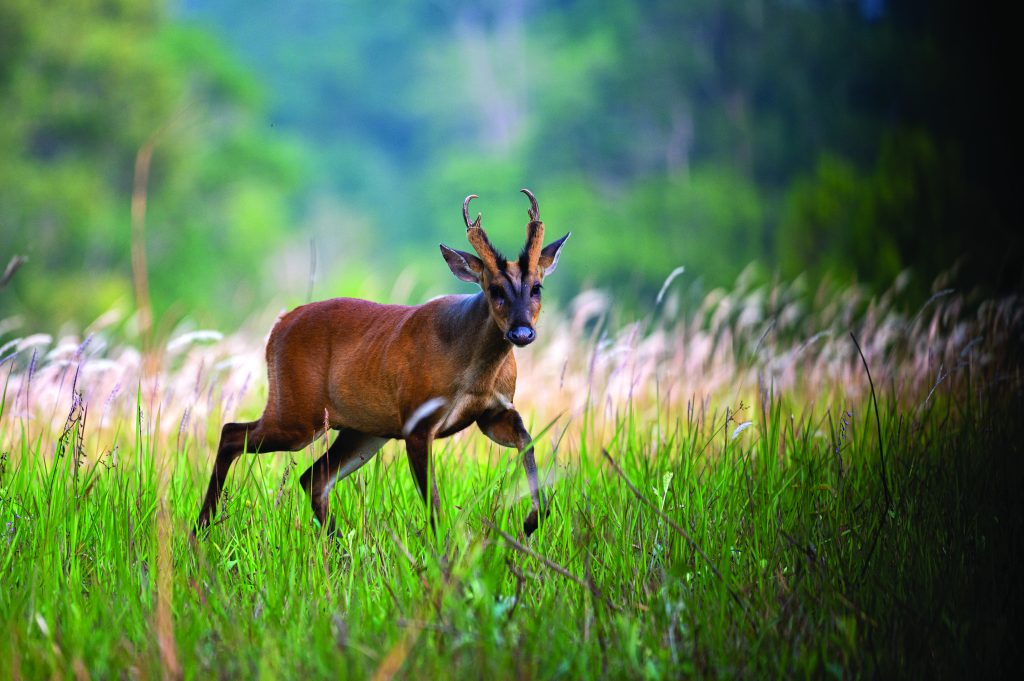
GOMARDA WILDLIFE SANCTUARY
Gomarda Wildlife Sanctuary, situated near Sarangarh town in the Raigarh district of Chhattisgarh, is popular with lovers of nature and wildlife. Spanning verdant forests and scenic landscapes, it serves as a natural habitat for a variety of rare and exotic species. The sanctuary is a significant ecological treasure, providing a tranquil retreat for those seeking to connect with nature and observe diverse wildlife in their natural surroundings.
Things To See
Gomarda Wildlife Sanctuary offers a chance to observe a diverse range of fauna in their natural habitat. The sanctuary is home to key species such as Nilgiri Tahr, Sambars, Gaurs, Barking Deer, Chausingha (Four-horned Antelope), Muntjac, Sloth Bear, Wild Boar, Dhole (Indian Wild Dog), and Jackal. Beyond its rich wildlife, the sanctuary boasts dense forests that provide breathtaking views and a peaceful ambiance. Visitors can also explore its scenic trails and small streams, making it an ideal destination for trekking and birdwatching.
How to Reach
By Air: Swami Vivekananda Airport in Raipur (180 km).
By Train: The closest railway stations are – Raigarh (78 km) and Raipur (188 km).
By Road: Raipur (188 km), Raigarh (78 km).
BADALKHOL WILDLIFE SANCTUARY
Badalkhol Wildlife Sanctuary, located approximately 160 km north of Raigarh in Chhattisgarh, is one of the most renowned wildlife reserves in the state. Covering a vast area with 44% of its terrain blanketed by dense forests, the sanctuary is a vital ecological hub and a must-visit destination for nature lovers. Known for its rich biodiversity, it provides a safe environment for numerous wildlife species and attracts bird enthusiasts from all over, earning the reputation of being a birdwatcher’s paradise.
What to See
The sanctuary is home to several species of mammals, including elephants, leopards, sambars, chitals, and wild boars, as well as smaller animals like foxes and civets. Birdwatchers can enjoy sightings of numerous local and migratory bird species, making it an excellent spot for ornithologists. The sanctuary’s green forests and breathtaking views enhance the overall experience, offering trekking and nature walk opportunities.
How to Reach
By Air: Swami Vivekananda Airport in Raipur (442 km), Maa Mahamaya Airport Ambikapur (93 km), Bilasa Devi Kevat Airport, Bilaspur (233 km)
By Train: The closest railway stations are – Raigarh (195 km) and Raipur (424 km).
By Road: Raipur (424km), Raigarh (194 km).
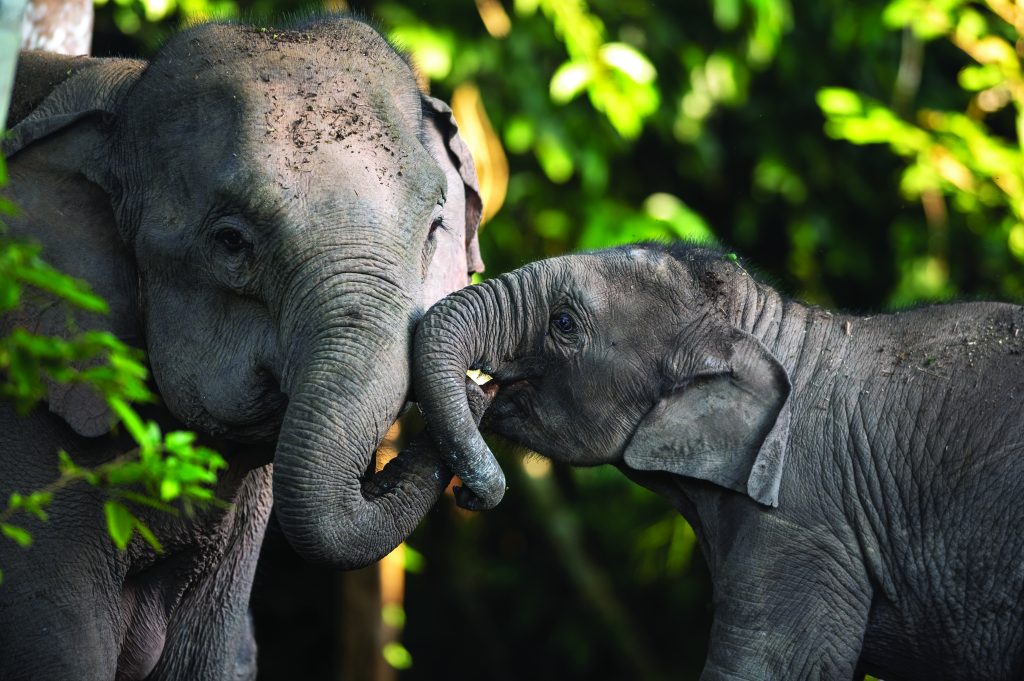
BHORAMDEV WILDLIFE SANCTUARY
Bhoramdev Wildlife Sanctuary, located in the Kawardha district of Chhattisgarh, covers an area of approximately 352 square km. Named after the famous Bhoramdeo Temple situated nearby, the sanctuary was declared a protected area in 2001 to conserve the region’s rich biodiversity. It is part of the Kanha-Achanakmar Corridor, a vital passage for the movement of wildlife, particularly tigers, between Kanha National Park in Madhya Pradesh and Achanakmar Wildlife Sanctuary in Chhattisgarh.
Things to See
The sanctuary offers a chance to witness a variety of wildlife, including tigers, leopards, sloth bears, sambars, and chitals. The numerous resident and migratory birds which are found here, make it an excellent destination for birdwatching. The landscape features tropical moist and dry deciduous forests, providing a picturesque backdrop for nature trails and safaris. Visitors can also explore the historic Bhoramdeo Temple, often referred to as the “Khajuraho of Chhattisgarh,” adding cultural significance to the sanctuary experience.
How to Reach
By Air: Swami Vivekananda Airport in Raipur (approximately156 km).
By Train: The closest railway station is in Raipur (approximately 137 km)
By Road: Raipur (approximately 140 km).
BHAIRAMGARH WILDLIFE SANCTUARY
Bhairamgarh Wildlife Sanctuary, located 48 km from Bijapur in Chhattisgarh, is a biodiversity-rich sanctuary known for its dense forests and the serene Indravati River. This sanctuary, nestled within a tropical climate zone, is teeming with wildlife and bird species, making it a significant destination for nature and wildlife photography.
Things to See
The sanctuary is home to the rare and endangered wild buffalo, which is one of its prime attractions. Other notable wildlife includes tigers, leopards, hill hyenas, chinkaras, Indian gazelles, chitals, nilgais, sambars, gaurs, barking deer, sloth bears, wild boars, jackals, and striped hyenas. Birdwatchers can enjoy spotting a variety of avian species such as darters, woodpeckers, peacocks, jungle fowls, green pigeons, quails, parrots, and storks, alongside migratory bird species. The sanctuary features mixed deciduous forests, teak forests, dry tropical river rain forests, and bamboo brakes, offering beautiful scenery and opportunities for trekking, nature walks, and photography.
How to Reach
By Air: Swami Vivekananda Airport in Raipur (375 km), Maa Danteshwari Airport Jagdalpur (approximately 119 km)
By Train: The closest railway stations are – Dantewada (39 km), Jagdalpur (115 km), Raipur (approximately 385 km).
By Road: Raipur (385 km), Jagdalpur (114 km), Dantewada (approximately 39 km).
SEMARSOT WILDLIFE SANCTUARY
Semarsot Wildlife Sanctuary, located near Semarsot on the Ambikapur-Daltonganj Road in the Surguja district of Chhattisgarh, is a protected area spread over 430.36 square km. Situated in the northern extension of the Ramgarh hills, it shares a border with Bihar to the east and lies along the Tropic of Cancer.
Things to See
The sanctuary is rich in flora, featuring sal, deciduous, and riverine trees, which provide a safe habitat for its diverse fauna. Wildlife enthusiasts can spot animals such as nilgai, spotted deer, sambar deer, chinkara, leopards, sloth bears, wild boars, and Indian foxes. Its picturesque landscapes, dense forests, and rolling hills make it an ideal destination for trekking, wildlife photography, and birdwatching.
How to Reach
By Air: Swami Vivekananda Airport in Raipur (approximately 434 km), Bilasa Devi Kevat Airport, Bilaspur (313km)
By Train: The closest railway stations are – Ambikapur (approximately 86 km), Raipur (416 km).
By Road: Raipur (418 km), Ambikapur (approximately 81km).
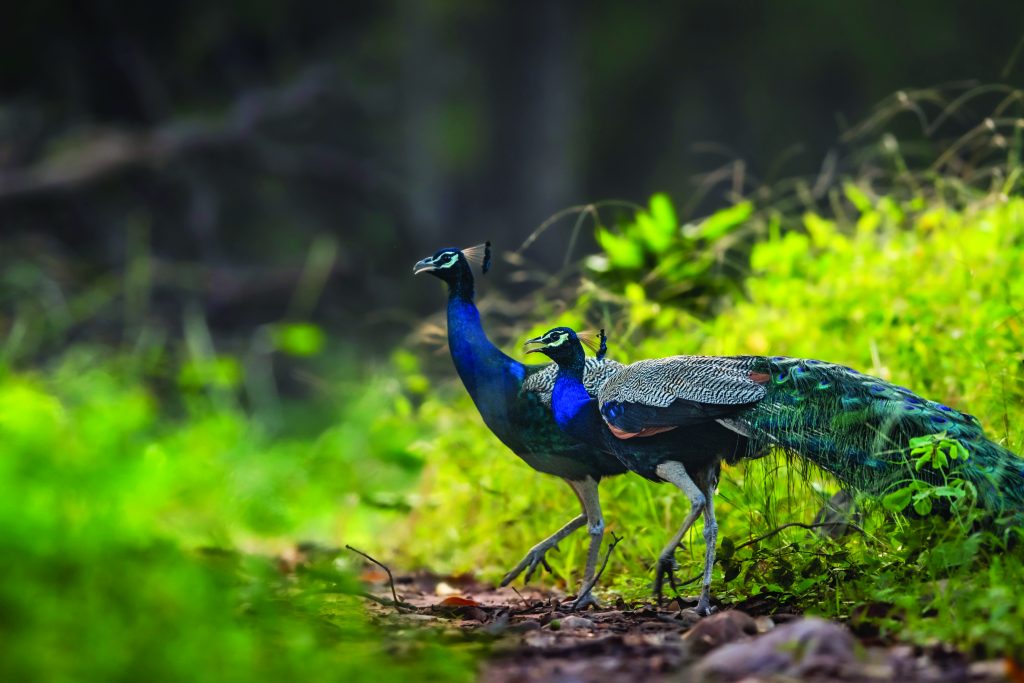
BARNAWAPARA WILDLIFE SANCTUARY
Barnawapara Wildlife Sanctuary, located in the northern part of the Baloda Bazar district of Chhattisgarh, is one of the most important wildlife reserves in the region. Established in 1976 under the Wildlife Protection Act of 1972, the sanctuary spans a modest area of 245 square km. Its topography includes flat and hilly terrains, with altitudes ranging between 265 and 400 meters. Known for its green vegetation and unique wildlife, Barnawapara attracts nature enthusiasts and wildlife lovers alike.
Things to See
The sanctuary is home to a rich variety of fauna, including Neelgai, wild boar, tigers, leopards, porcupines, pythons, antelopes, sambars, and chitals. A key attraction is the barking deer and the fearless Indian bison, or ‘Gaur,‘ considered the sanctuary’s main highlight. Barnawapara is also popular with birdwatchers, with around 150 bird species, including parrots, blackbucks, herons, egrets, and peafowls.
How to Reach
By Air: Swami Vivekananda Airport in Raipur (approximately 119 km).
By Train: The closest railway stations are – Mahasamund (83 km), Raipur (127 km).
By Road: Raipur (127 km), Mahasamund (82km).
This article is published in collaboration with Chhattisgarh Tourism Board
For latest travel news and updates, food and drink journeys, restaurant features, and more, like us on Facebook or follow us on Instagram. Read more on Travel and Food Network


